Giochi dell'Oca e di percorso
(by Luigi Ciompi & Adrian Seville)
(by Luigi Ciompi & Adrian Seville)

|
Giochi dell'Oca e di percorso
(by Luigi Ciompi & Adrian Seville) |

|
 |

Torna alla ricerca giochi (back to game search) |
 |
| Mansion (The) of Happiness | ||
 |
Versione stampabile
 |
Invia una segnalazione

|
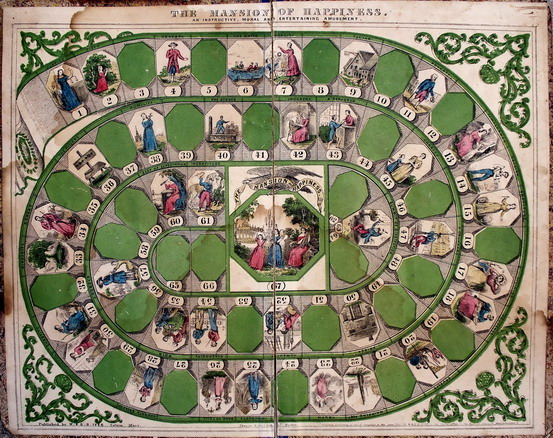 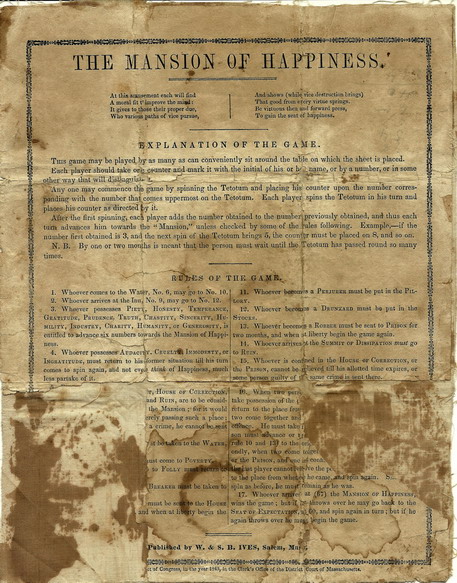 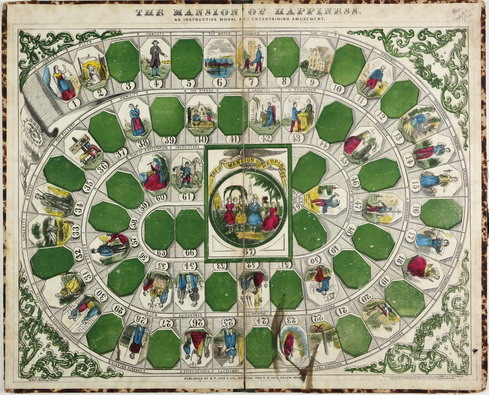 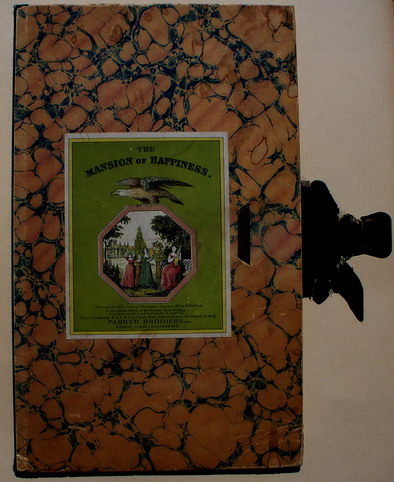 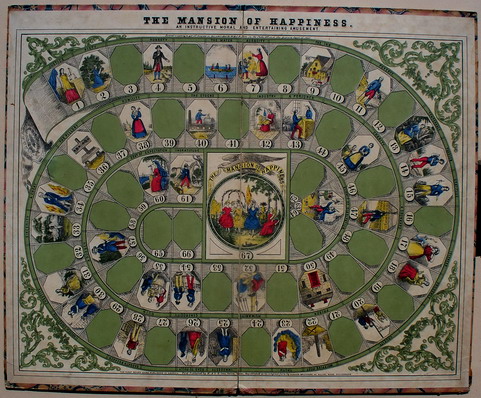 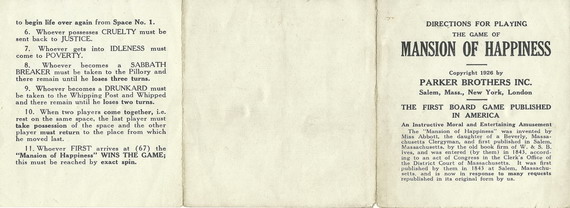 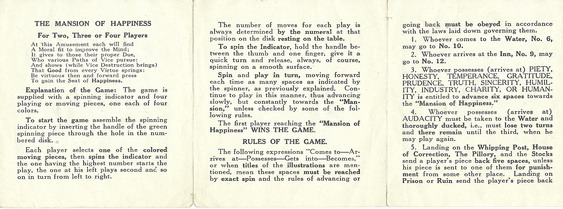 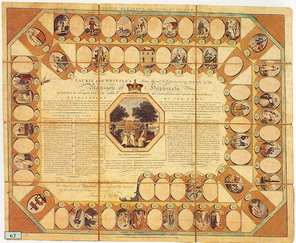  |
primo autore: | Anne W. Abbott |
| secondo autore: | Anne W. Abbott | |
| anno: | 1843 | |
| luogo: |
USA-Boston |
|
| periodo: | XIX secolo (2°/4) | |
| percorso: | Percorso di 67 caselle numerate | |
| materiale: | carta incollata su cartone ripiegato in 2 | |
| dimensioni: | 455X365 | |
| stampa: | Cromolitografia | |
| luogo acquisto: | Francia-Parigi | |
| data acquisto: | 20-10-1990 | |
| dimensioni confezione: | ||
| numero caselle: | 67 | |
| categoria: | Religione, Diritto e Morale | |
| tipo di gioco: | Gioco di percorso | |
| editore: | Published by W. & S. B. IVES Salem Mass.Thayer & Co.Lithografy Boston. | |
| stampatore: | Published by W. & S. B. IVES Salem Mass.Thayer & Co.Lithografy Boston. | |
| proprietario: | Collezione L. Ciompi - A. Seville | |
| autore delle foto: | L. Ciompi - A. Seville | |
| numero di catalogo: | 422 | |
| descrizione: |
Gioco di 67 caselle numerate, spirale, orario, centripeto. In basso: "Published by W. & S. B. IVES Salem Mass"; "Thayer & Co. Lithografy Boston"; "Entered according to Act. Uf. Congress in the year 1843 by W.&S. B. IVES in the Clerk’s Office of the District Court of Massachusetts" (la sigla Henry P. Ives and Co è nell’edizione del 1864). "The Mansion of Happiness" uscì per la prima volta a Londra nel 1800, con una riedizione il 1 settembre del 1851, ad opera di Robert Laurie e James Whittle ed era costituito da un percorso spirale di 67 caselle (Arch. n°1385). Nonostante l'assenza di caselle che fanno raddoppiare il punteggio ce ne sono diverse che fanno avanzare di sei caselle per raggiungere la destinazione finale: la Villa della Felicità. Queste rappresentavano le virtù della Pietà, Onestà, Sobrietà, Gratitudine, Prudenza, Verità, Castità, Sincerità, Umiltà, Industriosità, Carità, Umanità e Generosità. Per contro chiunque finisse sulle caselle dell'Audacia, della Crudeltà, dell'Indecenza o dell'Ingratitudine doveva fare ritorno alla situazione precedente senza neanche pensare alla felicità, figuriamoci prenderne parte. Tutte queste caratteristiche furono mantenute nelle versioni americane anche se furono apportate leggere modifiche per il pubblico di quel paese incluso il fatto di rinominare alcune caselle. I riferimenti alle prigioni londinesi di Bridewell e Newgate furono rimpiazzati con quelli della Casa di Correzione (casella 30) e alla Prigione (casella 50). Non era prevista una penalità per chi arrivava su queste caselle tuttavia i giocatori potevano essere costretti ad andarvi per crimini particolari: il ladro (chiunque giungesse alla casella 57) per esempio veniva spedito in prigione per due mesi (doveva saltare due turni) ma veniva liberato dall'arrivo di un altro giocatore. Una differenza significativa con l'originale inglese che si giocava con le poste, era il fatto che dall'edizione americana vennero rimossi tutti i riferimenti ai pegni. Si riteneva infatti che un gioco che enfatizzava i valori morali non potesse essere d'azzardo. REGOLE: non riportate sul tavoliere. CASELLE: alcune con didascalia. REFERENZA 1 "The Mansion of Happiness(1800). While most early board games bear the names of the publishers and the date of publication, few attest to the actual inventor if, of course, there was one. However, within the space of about one year, two moral games were “invented” by one man, George Fox, although the publishers of the games differ. The first game, The Mansion of Happiness, is a hand-coloured engraving published by Robert Laurie and James Whittle on October 13th, 1800. It has 67 compartments, which represent various virtues and vices together with, in the centre (67), a view of Oatlands Park, the residence of the Duke of York. This game is very harsh compared with the others. The “crimes” are serious - theft, lying, drunkenness, cheating - and the punishments include prison sentences, whipping, the stocks, and ducking. “Whoever gets into a Passion must be taken to the Water, have a ducking to coll him and pay a fine of one.” The Mansion of Happiness” is also the title of what is considered to be the first American board game, which was published by W & S B Ives in 1843. The Mansion of Happiness, an Instructive, Moral and Entertaining Amusement is claimed to be the first board game actually published in the United States. Published by W & S B Ives of Salem, Massachusetts in 1843, it bears great similarities to the 1800 Laurie and Whittle game of the same name . The American edition is said to have been the idea of a Miss Anne W Abbott, the daughter of a New England minister, but it is more likely that, if she actually had anything to do with the game, she might have presented it to the publishers as a game that might “properly” be played by children. The British and American versions are slightly different - the Laurie and Whittle one is more angular in design, for example - but the illustrated compartments and even the central picture are almost identical. The game was reissued several times, and by other publishers, including Parker Brothers in 1894. (Caroline Goodfellow) REFERENZA 2 (Love Brian): "THE MANSION OF HAPPINESS (1894). “The Mansion of Happiness”, invented by Miss Anne W. Abbott, a clergyman's daughter, was published in 1843, the first board-game ever published in America. In 1885 George Parker bought the rights to it and several other early games and reproduced it as faithfully as possible. The version shown here was issued in 1894. Rules of the game The object of the game is to be the first player to reach the Mansion of Happiness. This is a game far 2, 3 or 4 players. Each player should take one coloured counter. The player who throws the highest number on the die starts the game, placing his counter on the number on the board that he threw. The other players then do the same. Players continue to move on by the number thrown with the die, unless checked by the following rules. N.B. By one or two months is meant that the person must wait until all the other players have had so many turns. Players coming to marked squares must follow the instructions thereon. 1) Whoever comes to the Water, N°6, may go to N°10. 2) Whoever arrives at the Inn, N°9, may go to N°12. 3) Whoever possesses Piety, Honesty, Temperance, Gratitude, Prudence, Truth, Chastity, Sincerity, Humility, Industry, Charity, Humanity or Generosity is entitled to advance six numbers towards the Mansion of Happiness. 4) Whoever possesses Audacity, Cruelty, Immodesty, or Ingratitude must return to his former situation till his turn comes to throw again and not even think of Happiness, much less partake of it. 5) Poverty, the Whipping Post, the Pillory, the Stocks, Prison and Ruin are to be considered as blanks in your progress to the Mansion, and shall not count in reckoning the number of spaces to be moved, for it would be cruel to punish a person for merely passing such a place; therefore, till one is found guilty of a crime, he cannot be sent to either. 6) Whoever gets in a Passion must be taken to the Water, and have a ducking to cool him. 7) Whoever gets into Idleness must come to Poverty. 8) Whoever gets into the Road to Folly must return to Prudence. 9) Whoever becomes a Sabbath-Breaker must be taken to the Whipping Post and whipt. 10) Whoever becomes a Cheat must be sent to the House of Correction for one month and when at liberty begin the game again. 11) Whoever becomes a Perjurer must be put in the Pillory. 12) Whoever becomes a Drunkard must be put in the Stocks. 13) Whoever becomes a Robber must be sent to Prison for two months and when at liberty begin the game again. 14) Whoever arrives at the Summit of Dissipation must go to Ruin. 15) Whoever is confined in the House of Correction, or the Prison, cannot be relieved till his allotted time expires, or some person guilty of the same crime is sent there. 16) When two players land on the same square, the last to arrive takes possession of it. The first player must return to the square from whence he came. If the last player is found guilty of an offence, however, he must advance or return (unless he is a Cheat or Robber) to the original place of the last player. If two come together at the House of Correction or the Prison, and one is confined for a crime, as the last player cannot relieve the person confined, he must return to the place from whence he came and throw again. Should he throw as before, he must remain as he was. 17) Whoever arrives at (67) the Mansion of Happiness by an exact throw wins the game. If he throws over he must go back to the Seat of Expectation, at 60, and throw again in turn. If he yet again throws over he must begin the game again. (Great Board Games 1895-1955. Brian Love, Ebury Press). REFERENZA 3 Game 70: The Mansion of Happiness (American version) The Mansion of Happiness. Salem, Mass.: W. & S. B. Ives, 1843. Copper engraving with original stencil and hand color, laid on two-panel folding board edged with brown marbled paper, 38 x 45 cm. Lender: John Spear. Refs.: Ciompi/Seville 0422; Whitehill, pp. 9 and 95. This is the first edition of the American version of Game 68. For many years, this was thought to be the earliest American printed board game. The discovery of geographic games produced in 1822 by F. & R. Lockwood, a family of New York booksellers, disproved that notion. Nevertheless, this game, reissued several times by Ives and subsequently by Parker Brothers in 1894, remains an important landmark in the history of U.S. printed board games and Ives are credited with being the first major manufacturer of games in the country. The game is structurally identical to the English original, though there are differences in detail. The lists of virtues and vices are the same and have the same rules. One important difference is that the game is not played for stakes; there is no reference to fines in any of the penalties. Another is that the references to Bridewell and Newgate are replaced by the House of Correction (space 30) and the Prison (space 50). Other revisions have removed anomalies in the English game, e.g., those arriving at the Summit of Dissipation must go to Ruin, without the option of a fine, and the Seat of Expectation rule is adopted. (Adrian Seville) Exhibitions: - "The Royal Game of the Goose four hundred years of printed Board Games". Exhibition at the Grolier Club, February 23 - May 14, 2016 (Prof. Adrian Seville). |
|
| bibliografia: |
1) Wikipedia: The Mansion of Happiness 2) GOODFELLOW, Caroline: "A Collector's Guide to Games and Puzzles", Secaucus, New Jersey, Chartwell Books-London, Quintet Publishing Limited 1991. 3) GOODFELLOW, Caroline: "Jeux de société. Le guide du collectionneur des jeux de société depuis le XVIIIe siècle jusqu’à nos jours", (Edizione francese) Carrousel MS, 2001. 4) LOVE, Brian: “Great Board Game”, Ebury Press 1979. 5) SEVILLE, Adrian: "The Royal Game of the Goose four hundred years of printed Board Games". Catalogue of an Exhibition at the Grolier Club, February 23 - May 14, 2016. 6) SEVILLE, Adrian: "L'arte dei giochi da tavolo. Oltre un secolo di storia e divertimento dalla fine del Settecento all'inizio del Novecento." Edizioni White Star, 2019. |
|
Vai alla ricerca giochi Vai all'elenco autori